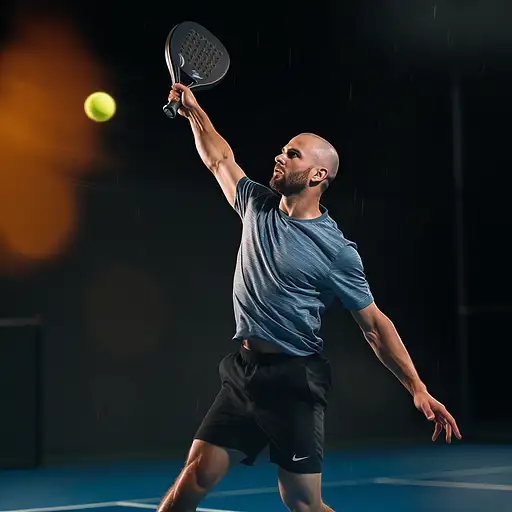3 months ago
Prompt principal (Stable Diffusion)
“Realistic sports photography, 40-year-old male padel player, brunette buzz-cut (almost bald), five-day stubble, striking a powerful overhead smash above his shoulders on a professional blue padel court, using a dark pro padel paddle with holes (no tennis racket), distant full-body shot, dynamic pose frozen mid-air, dark blurred background to accentuate motion, natural side lighting creating dramatic highlights and realistic shadows, detailed clothing textures (technical T-shirt, shorts), visible ball trajectory blur, crisp depth of field, 85 mm lens look, f/2.8, ISO 400, 1/2000 s –‐ green eyes sharply in focus — sharp, photorealistic, high detail, RAW style”
Variaciones
Ángulo bajo + contraluz
“Low-angle view, golden-hour backlighting, warm rim-light outlining the athlete, flare highlights, cinematic sports photo, ⌀85 mm, f/2.0, 1/4000 s, ISO 200”
Plano lateral con motion blur de fondo
“Side-view pan shot, background motion blur streaks, cool color grading, shutter 1/125 s, follows player, sense of speed, sports reportage style”
Iluminación artificial nocturna
“Night match under stadium LED floodlights, high-contrast lighting, cool white highlights, darker shadows, slight rain mist particles backlit, dramatic ambience”
Prompt negativo (sugerencia)
“tennis racket, extra limbs, extra balls, duplicate players, watermark, logo, text, cartoon, lowres, out of focus, deformed hands, bad anatomy, poorly rendered face, overexposed, underexposed”
Parámetros recomendados
Parámetro Valor sugerido Notas
Modelo base SD 1.5 / SDXL (fotográfico) O usa tu checkpoint fotográfico favorito (por ej., Realistic Vision).
Sampler DPM++ 2M Karras (ó Euler a) Karras suaviza luces; Euler a da contraste.
Steps 30-40 (1.5) / 25-30 (SDXL) Menos ruido residual en caras.
CFG Scale 6.5 – 7.5 Suficiente fidelidad sin over-constrain.
Resolución 1344 × 768 px (16∶9) Escena panorámica con margen lateral.
Aspect ratio --ar 16:9 (controlnet/resizable) Mantiene sensación de pista amplia.
Seed Ajusta; prueba 123456 para reproducibilidad Cambia para variar composición.
High-res fix / Upscale Latent → 2×, R-ESRGAN 4xSharp (0.33 denoise) Mejora texturas de pala y ropa.
ControlNet (pose) Activado (weight 0.8) Introduce esqueletos de smash para consistencia corporal.
LoRA / Embedding (opcional) “Sports-Photog-LoRA” @ 0.6 strength Refuerza estética fotográfica real.
Explicación técnica
Composición
Partimos de un plano lejano (long shot) con fondo oscurecido mediante bokeh y sub-exposición selectiva; esto dirige la atención al smash y al contraste azul de la pista. El ángulo de 85 mm simula un tele corto común en fotografía deportiva.
Iluminación
Natural side lighting crea modelado en músculos y marca la barba.
Para la variante nocturna, los LEDs ↑ contraste: compensa con rango dinámico (ISO 1600, pasos extra).
Color & detalle
La paleta fría (azul pista + verde ojos) contrasta con piel cálida; el prompt fija el paddle oscuro para evitar confusión con raqueta.
Negativo & CFG
El negative prompt elimina artefactos frecuentes (doble pala, tenis, textos). CFG ≈ 7 mantiene obediencia sin rigidez; sube a 8-9 si se desvían detalles clave (calvicie, ojos verdes).
Flujo SDXL
Genera base a 512 × 896 px (ratio 9:16 invertido si prefieres vertical), hi-res fix 2×, denoise ~ 0.25 con R-ESRGAN.
Opcional: ControlNet Pose o OpenPose para clavar anatomía del smash.














